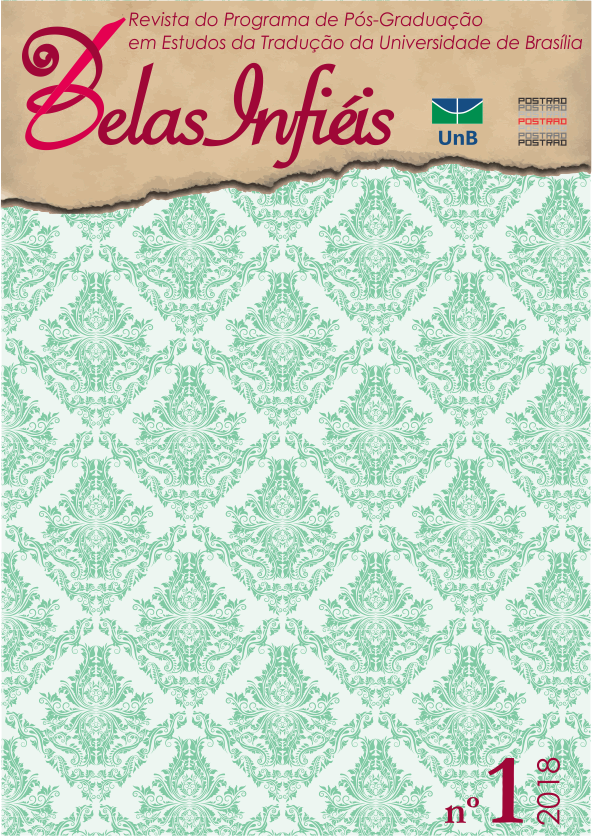On Translation and Its Twists
a reflection on the translation process of “Darle vueltas a una ceiba”
DOI:
https://doi.org/10.26512/belasinfieis.v7i1.12468Keywords:
Translation Studies, Translation Process, Hispanic American Literature, Cabrera InfanteAbstract
This article offers a reflection on the translation process of “Darle vueltas a una ceiba,” a short story by Cuban author Guillermo Cabrera Infante. Using the language of orality, the story paints an almost picturesque Havana, of its streets, its people, customs, and beliefs. Based on the idea that the translation process involves an aesthetic, ethical, and experimental activity, the reflections in this text expound on the author’s own experience with the adopted translation strategies, particularly with respect to the story’s cultural context and language, which fluctuates between vernacular, colloquial, burlesque, and ironic. The conceptual considerations in these pages are supported, above all, by three fundamental theoretical axes of literary translation theory: creative translation or transcription, as propounded by Haroldo de Campos (1962), linguistic hospitality, based on the theory of Paul Ricoeur and Antoine Berman, and the loyalty/faithfulness principle, addressed broadly by a range of translation scholars, including Humberto Eco.
Downloads
References
BERMAN, Antoine. A tradução e a letra ou o albergue do longínquo. Tradução Marie-Hélène C. Torres, Mauri Furlan, Andreia Guerini. 2. ed. Florianópolis: Copiart, PGET/UFSC, 2013. 200p.
BERMAN, Antoine. Toward a translation Criticism: John Donne. Tradução e edição Françoise Massardier-Kenney. Kent: The Kent State University Press, 2009. 249p.
CABRERA INFANTE, Guillermo. Todo está hecho con espejos. Cuentos casi completos. Madrid: Alfaguara, 1999.
CABRERA INFANTE, Guillermo. Tres tristes tigres. 7ª ed. Barcelona: Seix Barral, 1998.
CAMPOS, Haroldo de. Metalinguagem & outras metas. 4ª ed. São Paulo: Perspectiva, 1992.
DENIS, Alberto. ArrajaTabla: Como un volador de a peso. Una frase que acuñaron los cubanos de antaño. 2015. Disponível em: <http://arrajatabla.net/como-un-volador-de-a-peso/>. Acesso em: 07 fev. 2017.
ECO, Umberto. Quase a mesma coisa. Tradução de Eliana Aguiar. Rio de Janeiro: Record, 2007. 458p.
HALBWACHS, M. A memória coletiva. Tradução de Beatriz Sidou. São Paulo: Centauro, 2006.
MESCHONNIC, Henri. Ethics and politics of translating. Translated and edited by Pier-Pascale Boulanger. Tel Aviv: Benjamins Translation Library, 2007.
OLIVEIRA, Paulo. Tradução & ética. In: AMORIN, Lauro Maia; CARNEIRO RODRIGUES, Cristina; STUPIELLO, Érika Nogueira de Andrade (Orgs.). Tradução & perspectivas teóricas e práticas. 1.ed. São Paulo: Editora Unesp Digital, 2015. Disponível em: <http://static.scielo.org/scielobooks/6vkk8/pdf/amorim-9788568334614.pdf>. Acesso em: 15 jan. 2016. Páginas 71-97.
PEGENAUTE, Luis. La traducción del posmodernismo hispanoamericano: reflexiones sobre la interpretación de la cultura. Parallèles: Cahiers de l'École de Traduction et d'Interprétation de l'Université de Genève 19, 1997-1998, pp.177-192.
REAL ACADEMIA ESPAÑOLA. Diccionario de la lengua española. 22ª ed. Madrid, 2001. Disponível em: <http://www.rae.es/rae.html>. Acesso em: diferentes datas.
RICOEUR, Paul. Sobre a tradução. Tradução de Patricia Lavelle. Belo Horizonte: Editora UFMG, 2011. 71p.
RÓNAI, Paulo. A tradução vivida. Rio de Janeiro: EDUCOM, 1976.
TYMOCZKO, M. Translation and political engagement: activism, social change and the role of translation in geopolitical shifts. The Translator, v.6, n.1, p.23-47, 2000. Special Issue: Translation and Minority.
VENUTI, Lawrence. Escândalos da tradução. Tradução de Laureano Pelegrin et al. Bauru: EDUSC, 2002.
Downloads
Published
How to Cite
Issue
Section
License
Given the public access to this journal, the texts are free to use but requires the recognition of the original authorship and initial publication in this journal to be properly stated.
 The journal allows the use of works published for non-commercial purposes, including the right to submit the work to publicly accessible databases. Published contributions are the sole and exclusive responsibility of the author(s).Â



















